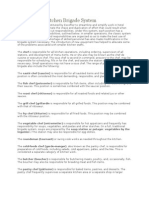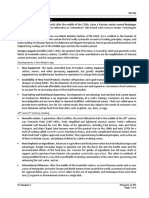0 ratings0% found this document useful (0 votes)
55 viewsKitchen Brigade
Kitchen Brigade
Uploaded by
Ven PrettyThe document defines the roles and responsibilities of various positions within a professional kitchen brigade. The chef de cuisine manages the overall kitchen operation including menus, recipes, purchasing, and staff training. Sous-chefs assist the chef de cuisine and represent the kitchen in their absence. Other positions include sauciers, chefs de partie who manage stations, commis who assist chefs de partie, and apprentices who perform preparatory work. Additional roles include specialized cooks for items like fish, soups, vegetables, as well as bakers, butchers and dishwashers.
Copyright:
© All Rights Reserved
Available Formats
Download as DOCX, PDF, TXT or read online from Scribd
Kitchen Brigade
Kitchen Brigade
Uploaded by
Ven Pretty0 ratings0% found this document useful (0 votes)
55 views2 pagesThe document defines the roles and responsibilities of various positions within a professional kitchen brigade. The chef de cuisine manages the overall kitchen operation including menus, recipes, purchasing, and staff training. Sous-chefs assist the chef de cuisine and represent the kitchen in their absence. Other positions include sauciers, chefs de partie who manage stations, commis who assist chefs de partie, and apprentices who perform preparatory work. Additional roles include specialized cooks for items like fish, soups, vegetables, as well as bakers, butchers and dishwashers.
Original Description:
Notes for food shap
Original Title
Kitchen-Brigade
Copyright
© © All Rights Reserved
Available Formats
DOCX, PDF, TXT or read online from Scribd
Share this document
Did you find this document useful?
Is this content inappropriate?
The document defines the roles and responsibilities of various positions within a professional kitchen brigade. The chef de cuisine manages the overall kitchen operation including menus, recipes, purchasing, and staff training. Sous-chefs assist the chef de cuisine and represent the kitchen in their absence. Other positions include sauciers, chefs de partie who manage stations, commis who assist chefs de partie, and apprentices who perform preparatory work. Additional roles include specialized cooks for items like fish, soups, vegetables, as well as bakers, butchers and dishwashers.
Copyright:
© All Rights Reserved
Available Formats
Download as DOCX, PDF, TXT or read online from Scribd
Download as docx, pdf, or txt
0 ratings0% found this document useful (0 votes)
55 views2 pagesKitchen Brigade
Kitchen Brigade
Uploaded by
Ven PrettyThe document defines the roles and responsibilities of various positions within a professional kitchen brigade. The chef de cuisine manages the overall kitchen operation including menus, recipes, purchasing, and staff training. Sous-chefs assist the chef de cuisine and represent the kitchen in their absence. Other positions include sauciers, chefs de partie who manage stations, commis who assist chefs de partie, and apprentices who perform preparatory work. Additional roles include specialized cooks for items like fish, soups, vegetables, as well as bakers, butchers and dishwashers.
Copyright:
© All Rights Reserved
Available Formats
Download as DOCX, PDF, TXT or read online from Scribd
Download as docx, pdf, or txt
You are on page 1of 2
Chef de cuisine
(kitchen chef; "chief of the kitchen")
is responsible for overall management of kitchen; supervises staff, creates menus and new recipes
with the assistance of the restaurant manager, makes purchases of raw food items, trains
apprentices, and maintains a sanitary and hygienic environment for the preparation of food.
Sous-chef de cuisine (deputy/second kitchen chef; "under-chief")
receives orders directly from the chef de cuisine for the management of the kitchen, and often
serves as the representative when the chef de cuisine is not present.
Saucier (saucemaker/sauté cook)
prepares sauces and warm hors d'oeuvres, completes meat dishes, and in smaller restaurants, may
work on fish dishes and prepare sautéed items. This is one of the most respected positions in the
kitchen brigade.[3]
Chef de partie (senior chef; "chief of the group")
is responsible for managing a given station in the kitchen, specializing in preparing particular
dishes there. Those who work in a lesser station are commonly referred to as a demi-chef.
Cuisinier (cook)
is an independent position, usually preparing specific dishes in a station; may also be referred to
as a cuisinier de partie.
Commis (junior cook / assistant cook)
also works in a specific station, but reports directly to the chef de partie and takes care of the
tools for the station. A woman is a commise.
Apprenti(e) (apprentice)
are often students gaining theoretical and practical training in school and work experience in the
kitchen. They perform preparatory work and/or cleaning work.
An apprenti is a male, and apprentie female.
Plongeur (dishwasher or kitchen porter)
cleans dishes and utensils, and may be entrusted with basic preparatory jobs.
Marmiton (pot and pan washer; kitchen porter)
in larger restaurants, takes care of all the pots and pans instead of the plongeur.
Rôtisseur (roast cook)
manages a team of cooks that roasts, broils, and deep fries dishes.
Grillardin (grill cook
in larger kitchens, prepares grilled foods instead of the rôtisseur.
Friturier (fry cook)
in larger kitchens, prepares fried foods instead of the rôtisseur.
Poissonnier (fish cook)
prepares fish and seafood dishes.
Entremétier / entremettier (entrée preparer)
prepares soups and other dishes not involving meat or fish, including vegetable dishes and egg
dishes.
Originally the entremets preparer.
Potager (soup cook)
in larger kitchens, reports to the entremétier and prepares the soups.
Legumier (vegetable cook)
in larger kitchens, also reports to the entremétier and prepares the vegetable dishes.[5]
Garde manger (pantry supervisor; "food keeper")
is responsible for preparation of cold hors d'oeuvres, pâtés, terrines and aspics; prepares
salads; organizes large buffet displays; and prepares charcuterie items.[3]
Tournant (spare hand/roundsman)
moves throughout the kitchen, assisting other positions in kitchen.
Pâtissier (pastry cook)
prepares desserts and other meal-end sweets, and for locations without a boulanger, also
prepares breads and other baked items; may also prepare pasta. [4]
Confiseur
in larger restaurants, prepares candies and petit fours instead of the pâtissier.[5]
Glacier
in larger restaurants, prepares frozen and cold desserts instead of the pâtissier.[5]
Décorateur
in larger restaurants, prepares show pieces and specialty cakes instead of the pâtissier.[5]
Boulanger (baker)
in larger restaurants, prepares bread, cakes, and breakfast pastries instead of the pâtissier.[4]
Boucher (butcher)
butchers meats, poultry, and sometimes fish; may also be in charge of breading meat and fish
items.[5]
You might also like
- Following Is A Generalized 1200 Cal Vegetarian Diet ChartDocument7 pagesFollowing Is A Generalized 1200 Cal Vegetarian Diet ChartSayari ChatterjeeNo ratings yet
- What Is The Kitchen BrigadeDocument9 pagesWhat Is The Kitchen BrigadeShommer ShotsNo ratings yet
- Kitchen and Restaurant BrigadeDocument26 pagesKitchen and Restaurant BrigadeCarlos Baul DavidNo ratings yet
- Principles of Food Selection, Preparation and ServiceDocument4 pagesPrinciples of Food Selection, Preparation and ServiceJohnny WilliamsNo ratings yet
- Brigade de CuisineDocument2 pagesBrigade de CuisineCheche Valdez100% (1)
- Brigade SystemDocument2 pagesBrigade Systemkul_angotNo ratings yet
- Career Opportunities in CookeryDocument38 pagesCareer Opportunities in CookeryjannaishadiazNo ratings yet
- Kitchen BrigadeDocument3 pagesKitchen BrigadeMiamie Nuyana CamposNo ratings yet
- Ms. Garingo Kitchen BrigadeDocument27 pagesMs. Garingo Kitchen BrigadeIlyn Sistoso GaringoNo ratings yet
- Brigade de CuisineDocument4 pagesBrigade de CuisineJannoel Rosete100% (1)
- Kitchen BrigadeDocument38 pagesKitchen BrigadeAthirah Ramli100% (1)
- Food Production BHIC1Document19 pagesFood Production BHIC1Katson IvyNo ratings yet
- Culinary Fundamentals With Lab: Lesson 1Document13 pagesCulinary Fundamentals With Lab: Lesson 1Katrina Bianca Buot PiencenavesNo ratings yet
- Food and Beverages DivisionDocument12 pagesFood and Beverages DivisionbernadethrabotNo ratings yet
- HM 102 Chap 2 The Kitchen Organization and LayoutDocument37 pagesHM 102 Chap 2 The Kitchen Organization and LayoutCatherine InglesNo ratings yet
- Class NotesDocument20 pagesClass NotesKatrina Bianca Buot PiencenavesNo ratings yet
- THE CLASSIC KITCHEN BRIGADE and Position by John Dee HortelanoDocument3 pagesTHE CLASSIC KITCHEN BRIGADE and Position by John Dee HortelanoJohn Dee HortelanoNo ratings yet
- AssignmentDocument3 pagesAssignmentNix CabagnotNo ratings yet
- Kitchen Organization, Unit 4Document24 pagesKitchen Organization, Unit 4Narendra Babu100% (1)
- Dip 2 Production Management NotesDocument35 pagesDip 2 Production Management NotesHillary OluochNo ratings yet
- Kitchen Essentials & Basic Food Preparation (HRM 026)Document30 pagesKitchen Essentials & Basic Food Preparation (HRM 026)Novel LampitocNo ratings yet
- Classical Brigade 3Document13 pagesClassical Brigade 3Marcillan MarquezNo ratings yet
- Guide To The Kitchen Brigade SystemDocument2 pagesGuide To The Kitchen Brigade Systemjoeker31No ratings yet
- Hpc1 Chapter 1 The Organization of Modern KitchensDocument12 pagesHpc1 Chapter 1 The Organization of Modern KitchensMichaella CasinioNo ratings yet
- Cas 101Document4 pagesCas 101Maurice AbaradoNo ratings yet
- Brigade System: Executive ChefDocument2 pagesBrigade System: Executive ChefAbdulBasit SATTARNo ratings yet
- Lesson A2 Career in Culinary ArtsDocument14 pagesLesson A2 Career in Culinary ArtsTaj BurryNo ratings yet
- Cookery IntroDocument20 pagesCookery IntroEda GadoyNo ratings yet
- Food Preparation and Presentation: by Aggrey Musoke PHD Tourism and HospitalityDocument12 pagesFood Preparation and Presentation: by Aggrey Musoke PHD Tourism and HospitalityCarzo Aggy MugyNo ratings yet
- Cookery - Module 1Document120 pagesCookery - Module 1Ehmz G. LaronNo ratings yet
- The Roles and Duties of Each Member ofDocument10 pagesThe Roles and Duties of Each Member ofIrine Limuardo SorianoNo ratings yet
- History of Modern Foodservice: Developments in The Modern AgeDocument3 pagesHistory of Modern Foodservice: Developments in The Modern AgeZyrah EspanaNo ratings yet
- Kitchen OrganizationDocument6 pagesKitchen Organizationlinda zaliNo ratings yet
- Zyryl G. Peping HAA Gmt1 February 18, 2013: Kitchen Staff Duties of Kitchen StaffDocument1 pageZyryl G. Peping HAA Gmt1 February 18, 2013: Kitchen Staff Duties of Kitchen Staffjustin_saneNo ratings yet
- Headline Title CHEFDocument4 pagesHeadline Title CHEFbdmoinNo ratings yet
- Kitchen Report KhushiDocument140 pagesKitchen Report KhushiKhushiNo ratings yet
- TVL 1 COOKERY LESSON 1 KITCHEN BRIGADE AutosavedDocument105 pagesTVL 1 COOKERY LESSON 1 KITCHEN BRIGADE AutosavedAl Lhea Bandayanon MoralesNo ratings yet
- Cookery 10 Quarter 1 IntroductionDocument56 pagesCookery 10 Quarter 1 IntroductionBSCRIM-1152-REYANN LAJANo ratings yet
- What Is The Kitchen BrigadeDocument8 pagesWhat Is The Kitchen BrigadeLhyn Zarriz Berjamin DumangonNo ratings yet
- Prepared by Yubraj Balami Yogendra Magar Unish RaiDocument28 pagesPrepared by Yubraj Balami Yogendra Magar Unish RaiKumar Satyam100% (1)
- The Brigade de CuisineDocument4 pagesThe Brigade de CuisineNguyễn Việt TrungNo ratings yet
- Core Concepts in Cookery 1Document32 pagesCore Concepts in Cookery 1吴振安No ratings yet
- Culinary Art SemDocument41 pagesCulinary Art SemKrunal VishwasraoNo ratings yet
- COOKERY - Module 1Document117 pagesCOOKERY - Module 1Clark Inovejas50% (4)
- Unit 1 Introduction To Kitchen CultureDocument21 pagesUnit 1 Introduction To Kitchen Culturejason mr.perfect11No ratings yet
- Kitchen Brigade SystemDocument6 pagesKitchen Brigade SystemBea Santos BarrozoNo ratings yet
- The Classical Brigade: Kitchen OrganizationDocument1 pageThe Classical Brigade: Kitchen OrganizationMaricel Sanchez - CostillasNo ratings yet
- The Organization of Modern KitchensDocument9 pagesThe Organization of Modern KitchensJohnson Macayan FernándezNo ratings yet
- P1.2 - Introduction To Kitchen BrigadeDocument14 pagesP1.2 - Introduction To Kitchen Brigadetsantuyo0% (1)
- Cookery Q & A: Alternative Titles For Cook: Cafeteria Cook, Fast Food Cook, Takeaway Food CookDocument7 pagesCookery Q & A: Alternative Titles For Cook: Cafeteria Cook, Fast Food Cook, Takeaway Food CookAkhil AkhilbabyNo ratings yet
- Kitchen Brigade System: Culinary ArtsDocument25 pagesKitchen Brigade System: Culinary ArtsVibhu100% (1)
- Cookery Ncii: Clean and Maintain Kitchen PremisesDocument117 pagesCookery Ncii: Clean and Maintain Kitchen PremisesKhan Nur100% (1)
- Cookery Module 1Document117 pagesCookery Module 1Yvonne Janet Cosico-Dela FuenteNo ratings yet
- Ass 1.1Document13 pagesAss 1.1Nur Afiqah RahmatNo ratings yet
- Kitchen Staff Organization: 1. The MenuDocument6 pagesKitchen Staff Organization: 1. The MenuRo NyNo ratings yet
- Fundamentals of Culinary ArtsDocument56 pagesFundamentals of Culinary ArtsAngelo AbiganiaNo ratings yet
- Opportunities in Culinary Arts ProfessionDocument22 pagesOpportunities in Culinary Arts Professionpink_chefNo ratings yet
- MODULE 1 LESSON 2 1st Sem 2022 23Document26 pagesMODULE 1 LESSON 2 1st Sem 2022 23althealouielajoyNo ratings yet
- Brigade de Cuisine - ppt1Document20 pagesBrigade de Cuisine - ppt1Stephen VisperasNo ratings yet
- Catering and Food Services Recipe for Fifty: Kitchen Operation and Management and European and Asia CulinaryFrom EverandCatering and Food Services Recipe for Fifty: Kitchen Operation and Management and European and Asia CulinaryNo ratings yet
- Accompaniment For DessertsDocument30 pagesAccompaniment For DessertsJezreel Kyllie TelanNo ratings yet
- WMF Presto BrochureDocument15 pagesWMF Presto BrochureDeepakNo ratings yet
- Sharjah Bakery7Document10 pagesSharjah Bakery7mairaj zafarNo ratings yet
- Weekly Menu VesselDocument4 pagesWeekly Menu VesselBill MitzNo ratings yet
- Sample 1550 Calories Weight Loss Meal Plan 3m2sDocument1 pageSample 1550 Calories Weight Loss Meal Plan 3m2sapple monteroNo ratings yet
- RB WeightLoss-MP-Compressed 1Document3 pagesRB WeightLoss-MP-Compressed 1SaulatNo ratings yet
- Coca Cola Animated Powerpoint PresentationDocument10 pagesCoca Cola Animated Powerpoint PresentationVõ Ngọc Kiều DiễmNo ratings yet
- Kerala Appam/Palappam - The Familiar KitchenDocument18 pagesKerala Appam/Palappam - The Familiar KitchendineshNo ratings yet
- Kazoku Teppanyaki MenuDocument24 pagesKazoku Teppanyaki MenuAlingNo ratings yet
- The New Wildcrafted Cuisine-Exploring The Exotic Gastronomy of Local Terroir (Pascal Baudar, 2016)Document440 pagesThe New Wildcrafted Cuisine-Exploring The Exotic Gastronomy of Local Terroir (Pascal Baudar, 2016)Javier Eduardo Valladolid YañezNo ratings yet
- 2 - 7 - Coffee CultureDocument13 pages2 - 7 - Coffee CultureManishNo ratings yet
- VBMenuforTrainNo 20607-08Document5 pagesVBMenuforTrainNo 20607-08Joshua GnanarajNo ratings yet
- Lesson 3 Enjoy The Tasty WorldDocument2 pagesLesson 3 Enjoy The Tasty Worldx00elias00xNo ratings yet
- Food Panda - LaraDocument4 pagesFood Panda - LaraLarah BuhaweNo ratings yet
- TLE Q4 Week 2 - ADocument11 pagesTLE Q4 Week 2 - AsignejohnrickkuNo ratings yet
- 2019 Seasonal India PosterDocument1 page2019 Seasonal India PosterNaga VamsiNo ratings yet
- DETAILED LESSON PLAN IN Cookery Week 7Document7 pagesDETAILED LESSON PLAN IN Cookery Week 7lovymae.ragmacNo ratings yet
- RiddlesDocument3 pagesRiddlesCamilo Andrés Urriago ReyesNo ratings yet
- MAPEH and TLEDocument5 pagesMAPEH and TLEClydeNo ratings yet
- Sanchez Mira School of Arts and Trades Senior High School The Problem and Its BackgroundDocument8 pagesSanchez Mira School of Arts and Trades Senior High School The Problem and Its BackgroundDiana Grace TabalbagNo ratings yet
- Lesson 3 - Further ReadingDocument4 pagesLesson 3 - Further ReadingDung Nguyễn ThịNo ratings yet
- W20 - CookbookDocument76 pagesW20 - CookbookTrevor TrowbridgeNo ratings yet
- ĐỀ THI THỬ ANH7 - CKIDocument6 pagesĐỀ THI THỬ ANH7 - CKIHoa NhiNo ratings yet
- Cookery-9-Third-Periodical TestDocument3 pagesCookery-9-Third-Periodical TestJennifer HolmNo ratings yet
- VegetarianismDocument14 pagesVegetarianismShackayla HenclewoodNo ratings yet
- UntitledDocument4 pagesUntitledirfan edisonNo ratings yet
- The Review Paper On Food Jam Product Ijariie15380Document5 pagesThe Review Paper On Food Jam Product Ijariie15380ngasludi31No ratings yet
- 10 q2m4Document49 pages10 q2m4Yannah Fei RubinoNo ratings yet
- Global Coffee Market - Industry Analysis and Forecast 2024-2030Document15 pagesGlobal Coffee Market - Industry Analysis and Forecast 2024-2030Munkhgerel UndralboldNo ratings yet

























































































